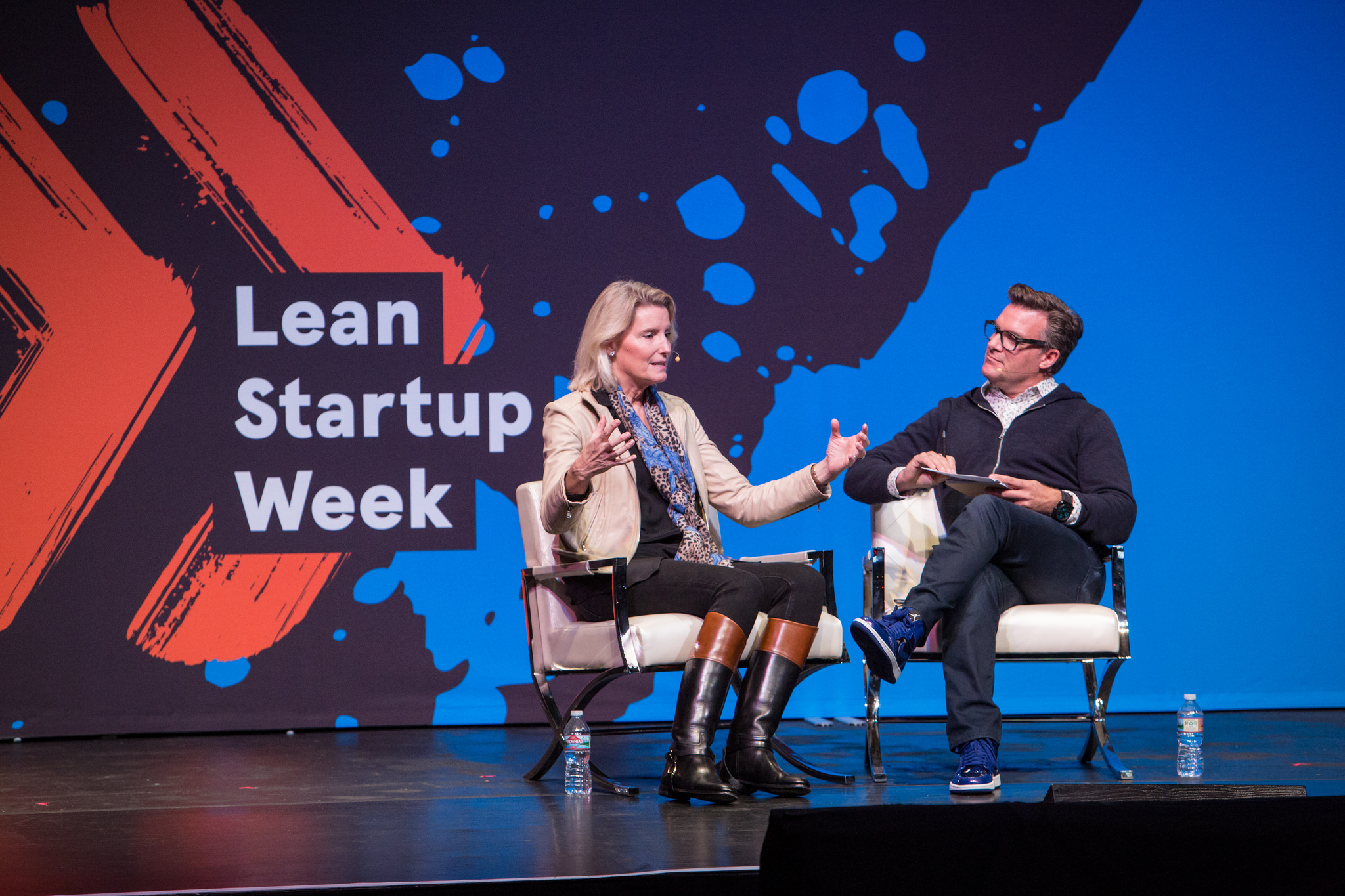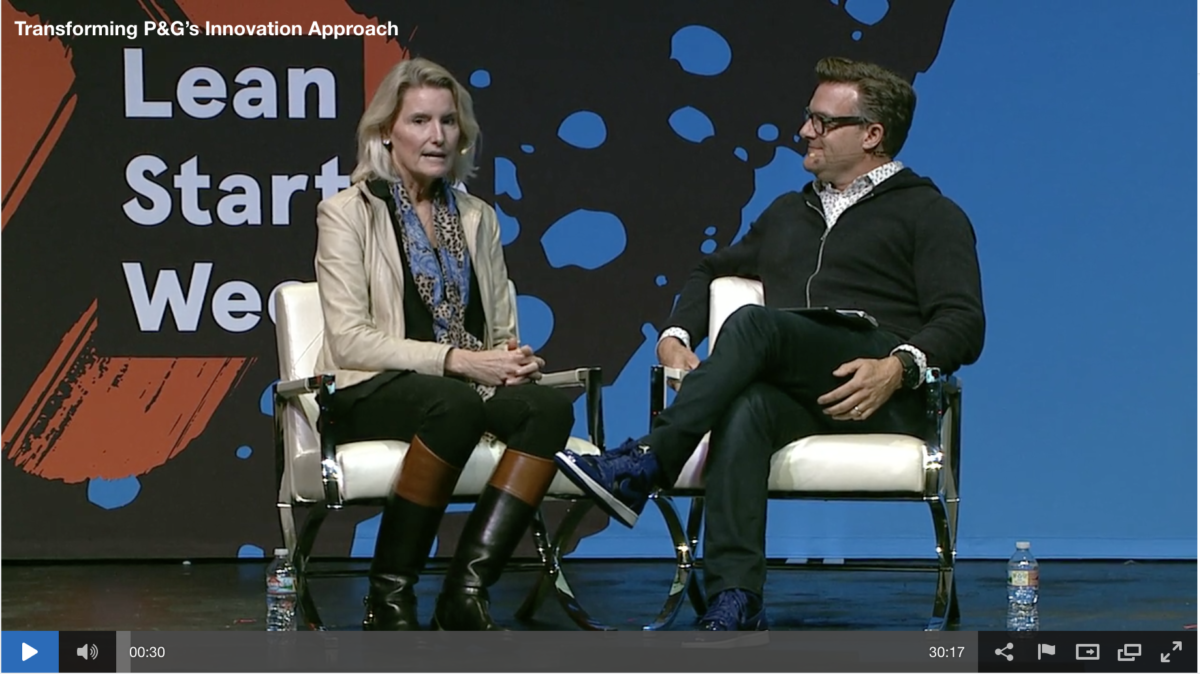How Procter & Gamble Uses Lean Startup to Innovate

Procter & Gamble CTO Kathy Fish shares P&G’s Lean Startup-inspired innovation strategy. When Kathy took over as CTO at Procter and Gamble in 2014 (which, she points out means head of R&D, not IT), she said “We were spending a lot of money, sometimes before we really should have.” So they began several Lean Startup experiments.
These were so successful, they decided to take it to the enterprise, and connected with Lean Startup founder, Eric Ries.
One of the biggest takeaways from launching this methodology, Kathy says, is that they’ve learned “When you fall in love with the problem and not the solution it opens your mind up in a really different way.”
They had formerly been a company that fell in love with solutions first, so to speak, but switching allegiances to the problem allowed them to see business model opportunities, marketing and educational opportunities, as well as product opportunities. “It’s just much, much richer,” Kathy says.
Because they are a product-focused company, they would often find themselves way down the path toward industrializing their products before they knew if the business model was successful or not. “So now we’ve shifted to a more metered funding approach. And we’re finding on some of our biggest programs that we’re learning faster, we’re getting to the consumer a lot faster and we’re spending 25 to 50 percent less money along the journey.”
“When you fall in love with the problem and not the solution it opens your mind up in a really different way.” -Kathy Fish, CTO of @ProcterGamble Click To TweetLean Startup creates an entrepreneurial spirit
Big enterprise doesn’t always make room for entrepreneurs, but Kathy says the best part of all the experimentation they’re doing now is that they’ve created small, multifunctional teams that learn together, and as a result, “The people that are on the teams are so inspired because they own their spaces, they feel like they can really make a difference and they own decision rights.”
The teams only have to report on what they’ve learned in order to get more money for their projects. Kathy raves about the results, “If they haven’t learned anything, they don’t get more money, but if they have, great—they get funded. It’s been really powerful.”
To pull these teams off requires “leaders who are very ambidextrous and able to know which space they’re in and how they should operate,” she explains. The entrepreneurial spirit she described is helping to empower leaders at every level where people are getting clear “on their leap of faith assumptions and running tests against them.”
More experiments, less money
While Kathy feels that P&G is already good at a key component of Lean Startup—keeping the consumer “at the center” of the work, and “really being obsessed with their pain points” she says the method has encouraged them to learn how to experiment more cheaply.
“We’re learning that what we thought was fast and cheap is still really slow and very expensive and we can go much faster and do much better.”
Part of that process has been taking what she calls more of a “venture capital approach” about what they’ve learned, and that includes being “more honest and open about talking about our failures.” She feels that projects can only really be successful when people are willing to do that.
On the positive side, she points out that they have “five times more experiments that are actually transactional learning experiments.”

Unlearning
When asked what her biggest area of “unlearning” as a leader when putting Lean Startup principles into play, Kathy said she’s trying to figure out “how to be a true partner to the commercial leaders who are in charge of overseeing these new lean experiments.
She is impressed with the leaders’ interest in Lean Startup, however. “They’re all really, really trying to learn,” she says. While this means that everyone “is a little uncomfortable” she thinks that’s exciting for its growth potential.
However, Kathy acknowledges that unlearning old ways of working isn’t easy for management. “The other thing we have to unlearn is, if in an organization the teams report to an executive sponsor to the growth board, you’ve got a whole level of middle managers who have to play a totally different role—either break barriers, mentor, or don’t be involved at all.” She says this can be difficult and threatening, “so we have to work our way through that as well.”
Insofar as this is an issue of changing the culture, she feels strongly that culture changes happen not by talking about them but “working differently.” The change happens organically that way, which is something she sees happening.
Another area of unlearning is a “reliance on volume forecast.” In its place she says they’ve realized that they have to look to “consumer love” and ask what consumers are passionate about, why are they passionate about it, and how many people are passionate about it.
She also admits they’ve got to find ways to work around P&G’s “consensus culture,” in which often one person with a big idea would often get shot down by others for being “dumb.” But now, she says, “We’re going to go learn about it, we’re going to experiment. We’re going to let the data tell us what’s right in a more manageable way.”
Reduce risks, not experiments
Kathy’s not above admitting where P & G needs to work harder, either. She can see places where they’ve scaled too fast, which can be a problem due to the sheer size of the company. “If we take something to the trade and tell them it’s going to be big and they invest in it, if it’s not quite right and we need to pivot, it’s really hard to do because they’re not happy with us.”
However, they don’t want to cripple the entrepreneurial spirit they’re starting to see spread throughout the company by pulling back too hard. So they still have to take risks, but she says Lean Startup is teaching teams to pull back and “right size” their risks and to invest less money in tests. “If you lose $1 million, it’s not perfect, but it’s not 500 million. So what really helps people to be more courageous is the size of the risk they’re taking along the way.”
After all, she notes, “You cannot be an innovation leader without a ton of courage.”
“You cannot be an innovation leader without a ton of courage.” -Kathy Fish, CTO of @ProcterGamble Click To TweetThank you to Jordan Rosenfeld for contributing this piece. If you seek to bring the entrepreneurial spirit to your organization, Lean Startup Co. can help.

